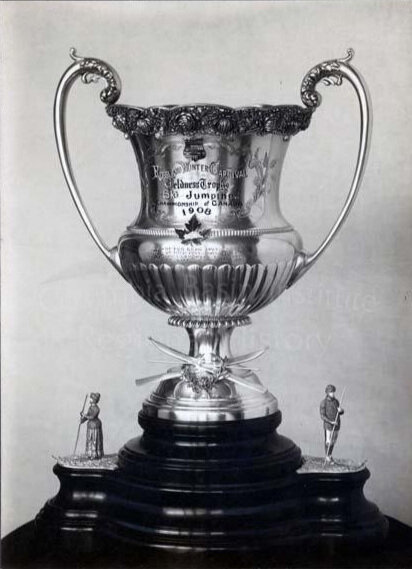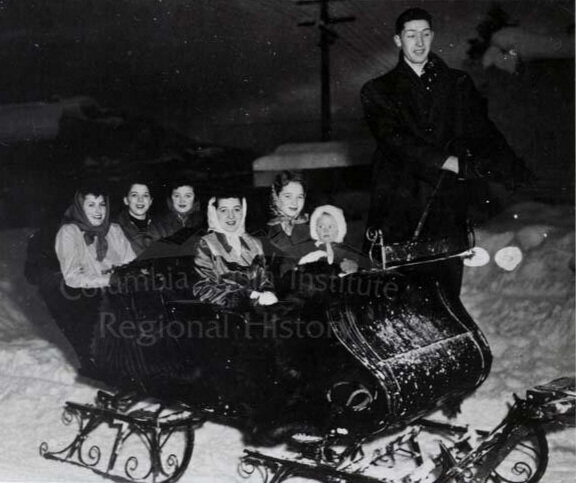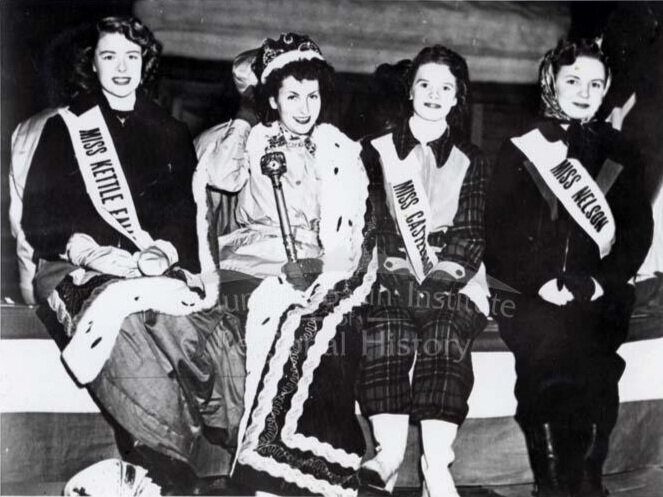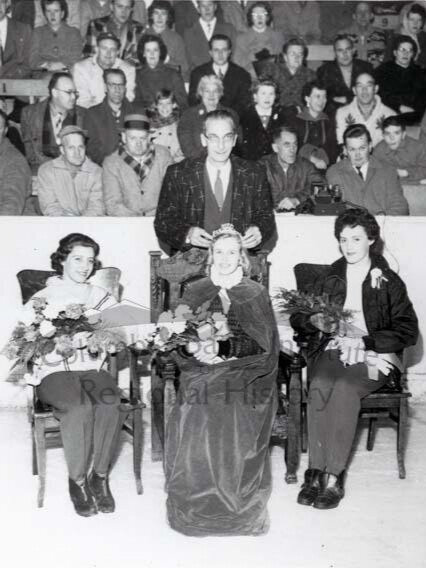Rossland Winter Carnival
The Rossland Winter Carnival first began in February 1898. Olaus Jeldness, who is credited with bringing the sport of skiing to Rossland, was also instrumental in the creation of Winter Carnival. Originally, ski-jumping and ski-running were the main attractions. Rosslanders would gather en masse to watch the exhilarating events, located at Red Mountain, Monte Cristo Mountain, and Downtown Rossland. The most popular skier was Olaus Jeldness, himself, who won the “Ski Championship of Canada” from 1898 to 1900, and remained active in Winter Carnival until around 1910.
The Winter Carnival also included hockey, curling, skating, tobogganing, and snowshoeing. Hockey, in particular, became a popular event, and even introduced the famous Rossland Ladies’ Hockey Team. Formed during the 1900 Winter Carnival, the team remained undefeated between 1900-1917, winning the Ladies’ Hockey Championship of BC every year. In 2018, the Rossland Ladies’ Hockey Team was inducted into the BC Sports Hall of Fame. The Winter Carnival also hosted non-sporting events. Masquerade On Ice, for example, was a popular event in which participants would don a masquerade mask and an elaborate costume at the Rossland Arena.
The Rossland Winter Carnival was held annually until February 1917. In 1918, the continuing war effort, the Spanish Influenza and the subsequent economic crisis prevented the continuation of the Winter Carnival. However, after a thirty-year hiatus, the Winter Carnival made a triumphant return in 1947, introducing new events such as the bobsled races and the Snow Queen Pageant. The revived Winter Carnival ran annually until January 2020. The COVID-19 pandemic prevented the 2021 Winter Carnival, but since 2022 it has been back and growing better than ever.
The First Winter Carnival
From the beginning, Winter Carnival has been a community affair, run by volunteers. An article in The Rossland Miner, Jan 15 1898, announced that it was decided at “a well-attended public meeting” to “leave the arrangements of the details of the affair to a general committee.” Committee members included such notable Rosslanders as Ross Thompson, Olaus Jeldness, and Rev. H Irwin (“Father Pat”). Accounts in the Miner reveal the early plans to hold two days of sports, including ski racing, hockey matches, skating races, snowshoeing races, ski jumping competitions, and a costume contest at the skating rink. Coverage of the event indicates that even early into 1898, Rosslanders were planning to make the Winter Carnival a recurring event - which they certainly did.
The Rossland Miner, February 16, 1898. Weather is always a critical - and uncontrollable! - element of the Winter Carnival.
Excitement surrounding the event grew in the following weeks as the program increased in scope. According to the Miner, public opinion was firmly behind the event, as one report announced of a fundraising campaign that “scarcely anyone who was approached declined to give something towards the expenses of the carnival.” Railway companies were approached to offer discounted rates to out-of-town visitors for the weekend, as it was expected that a “large number should be attracted to Rossland on this occasion.” To further the sense of occasion, announced that “it has been decided to open the festivities with a grand ball,” held at the Hotel Allan. The town was preparing for a great event.
By the time the full program of events was released in early February, the festivities spanned Thursday, Friday, and Saturday, February 17-19, 1898, and events included hockey tournaments, a grand carnival ball, a curling bonspiel, snowshoe races (one for prospectors, one that was open to all), ski racing (with expert and novice categories), a coasting (sled) race, skating races, a “fancy skating competition,” and ski jumping competitions (organized by Olaus Jeldness, naturally). The affair would conclude with a “Grand Masquerade Carnival” and presentation of prizes at the Palace Skating Rink.
The event proved a great success. The Miner could not stem its praises of the “reign of revelry” and “well contested events” of that first Winter Carnival. “Although the first of the annual carnivals to be given here,” it reported, “it was as successful throughout as its fondest supporters had anticipated…The visitors…speak most pleasantly of their courteous reception while in the city, and give assurance that they will return next year.”
Olaus Jeldness in the First Carnival
1967.274.1 & 1967.276.1: Olaus Jeldness’ Winter Carnival medals, 1898.
Ski racing and ski jumping were two of the most highly anticipated events of the early Carnivals. Olaus Jeldness, who is credited with bringing skiing to the area, was a member of the 1898 Winter Carnival committee and one of three in the sub-committee responsible for planning the ski racing events. Olaus, who was understood to have once held the world’s record for ski jumping, was Rossland’s popular favourite for the 1898 competition. During the leadup to the event, The Rossland Miner reported on potential challengers to the championship, including J. L. Parker, the champion ski runner of Montana. “On Saturday,” the Miner wrote in Jan 1898, Parker “went up on Red mountain [sic] nearly half way to the top and came down over some pretty rough ground without colliding with the trees or brush that stood in the way. He seems to be a very skillful and steady ski runner and his friends think that he can give Olaus Jeldness the race of his life.” Other competitors included “several ski men from the Selkirk mountains. They are employes [sic] of the C.P.R. and are on skis for months at time, and are experts in every sense of the word. They feel as comfortable coming down the sides of a hill like Red mountain on their skis as does the ordinary individual on the level sidewalk.”
In spite of these fears, Olaus pulled off a win on Saturday’s ski jumping competition.
“ The racers climbed to the top of the mountain and then, fastening on their skis, slid down the slope at an amazing speed, dodging the while among the clumps of trees and brush that dot the mountain side.”
The ski jumping race was also won by Olaus Jeldness, while his brother Andrew Jeldness came in second place. “As the ground was ill adapted to ski jumping,” wrote the Miner, “no records were made.”
The “ski racing for championship of Canada,” which was held on Friday, February 18, 1898, had only three contestants Olaus Jeldness, his brother Andrew Jeldness, and Thorwald Hartman. The course ran “from the summit of Red mountain [sic] to the Black Bear compressor,” the current site of the Rossland Museum. Hartman broke his skis on the descent and was unable to finish, but the Jeldness brothers persevered through treacherous conditions and concluded the race. Olaus was awarded the gold, Andrew the silver.
The ski races included a race for novices - “open to all who have never run on skis prior to this winter.” The Miner reported that the race was “laughable,” resulting in contestents’ being “literally covered with snow,” but concluded that “nevertheless they kept on, and at last most of them finished in a greater or less degree of collapse.” Perhaps not a very auspicious start - but the inclusion of the event suggests that Olaus and his efforts were successful in introducing the sport to other Rosslanders!
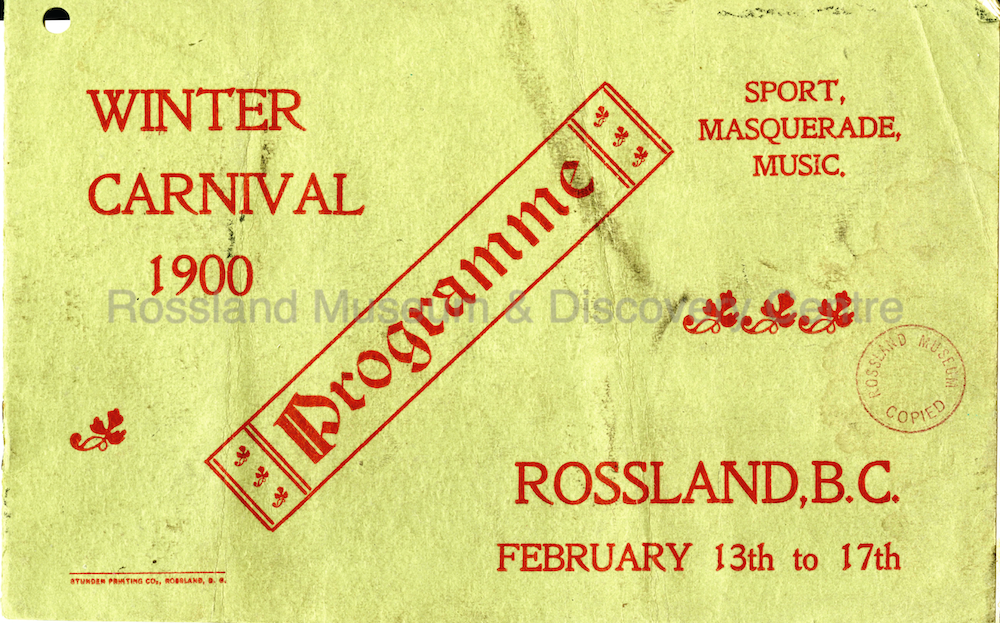
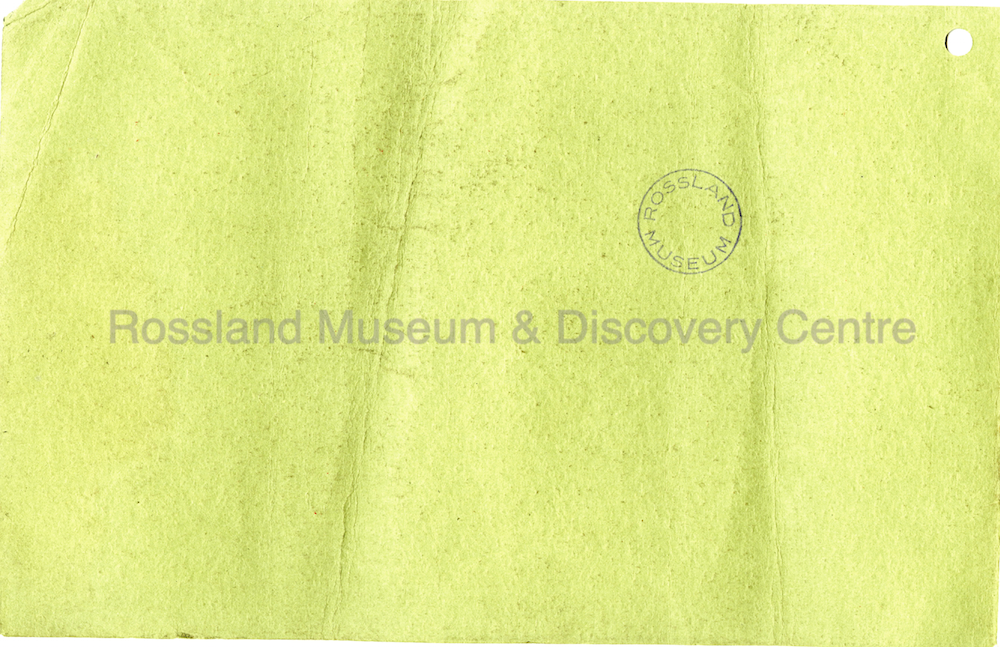

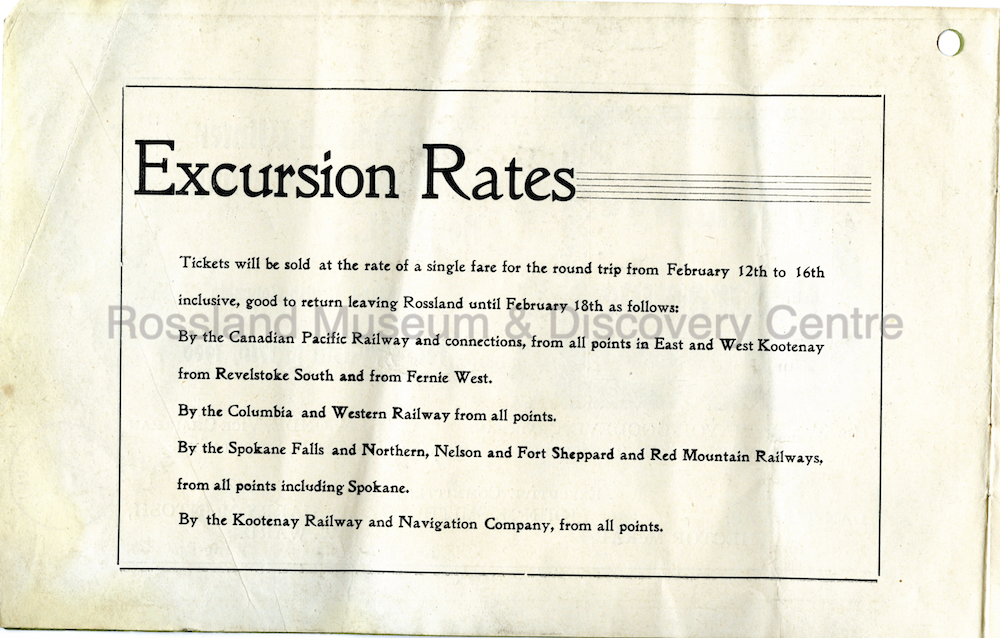


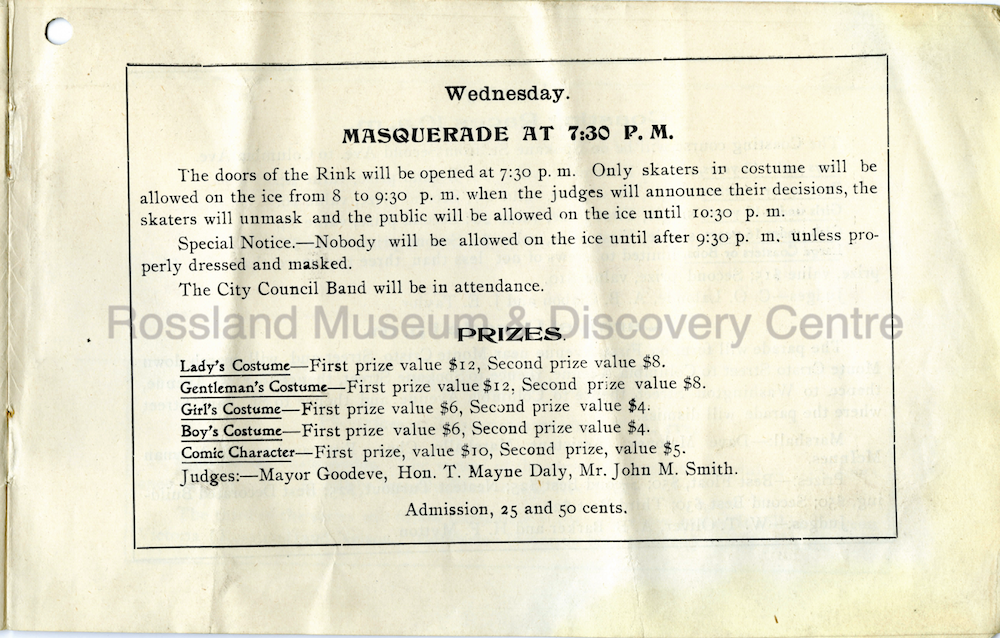

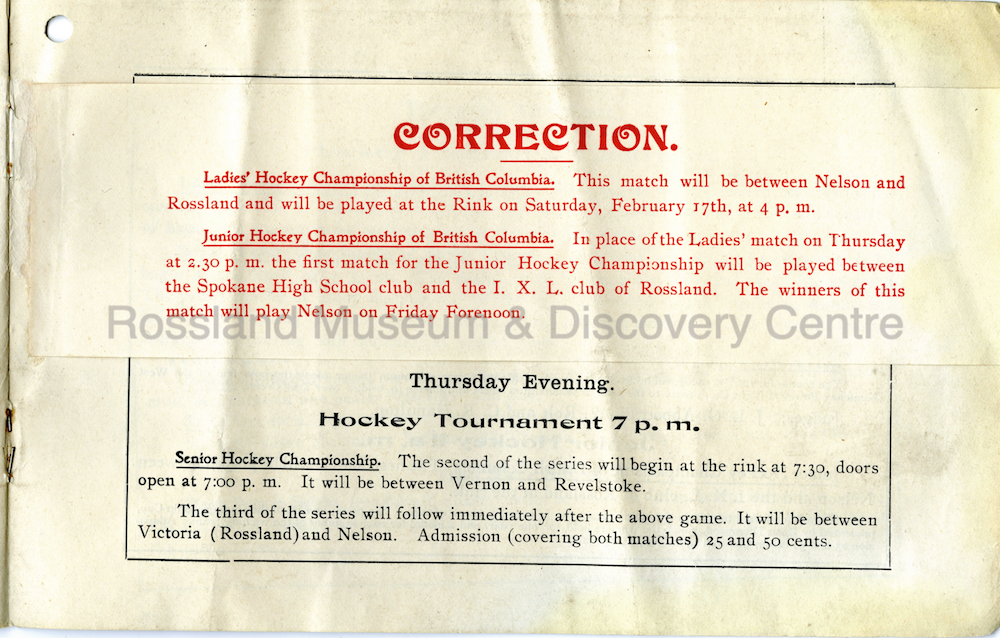
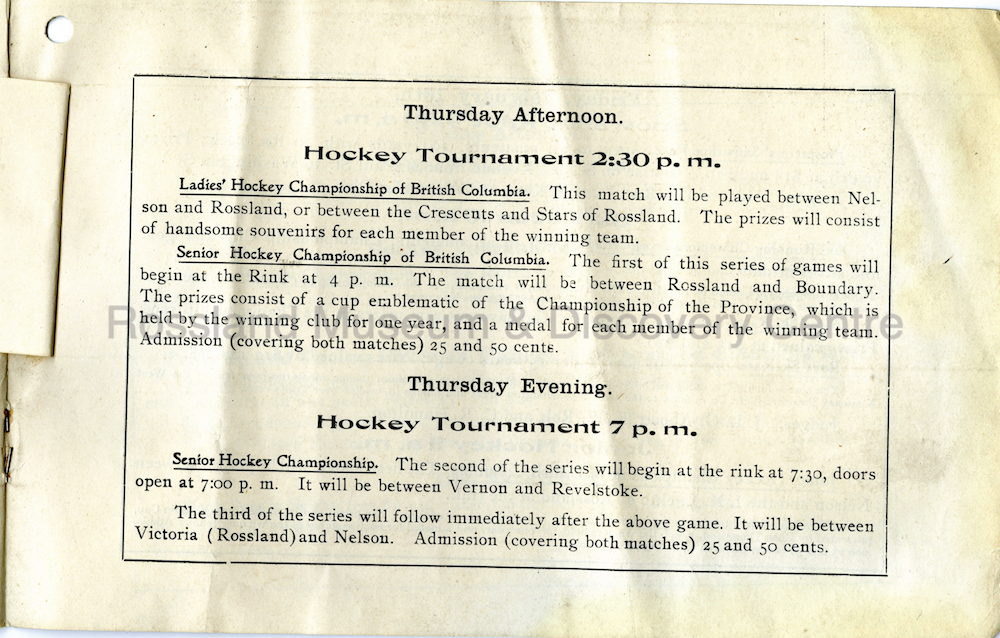
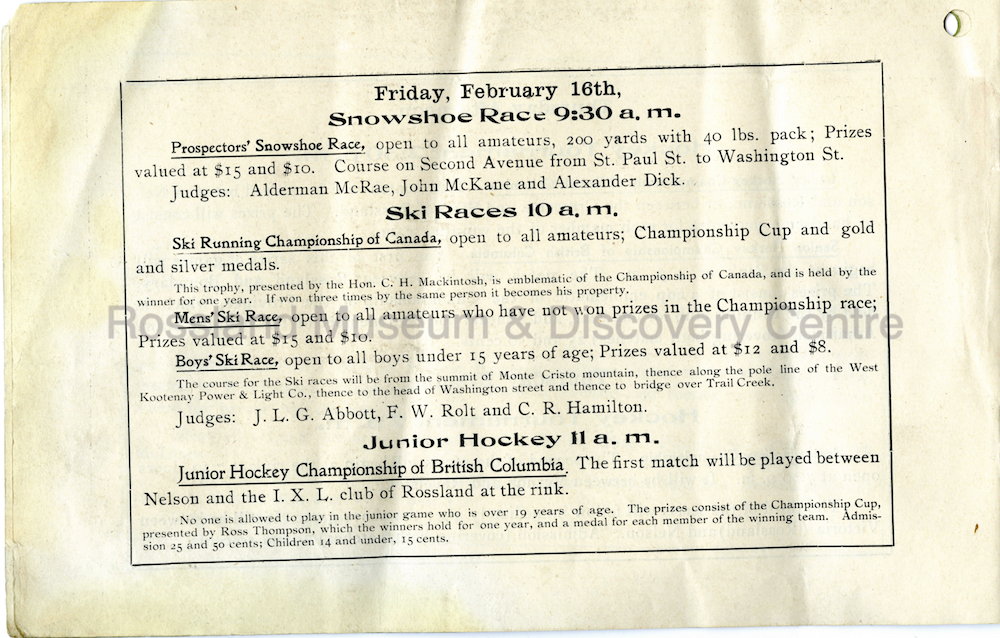
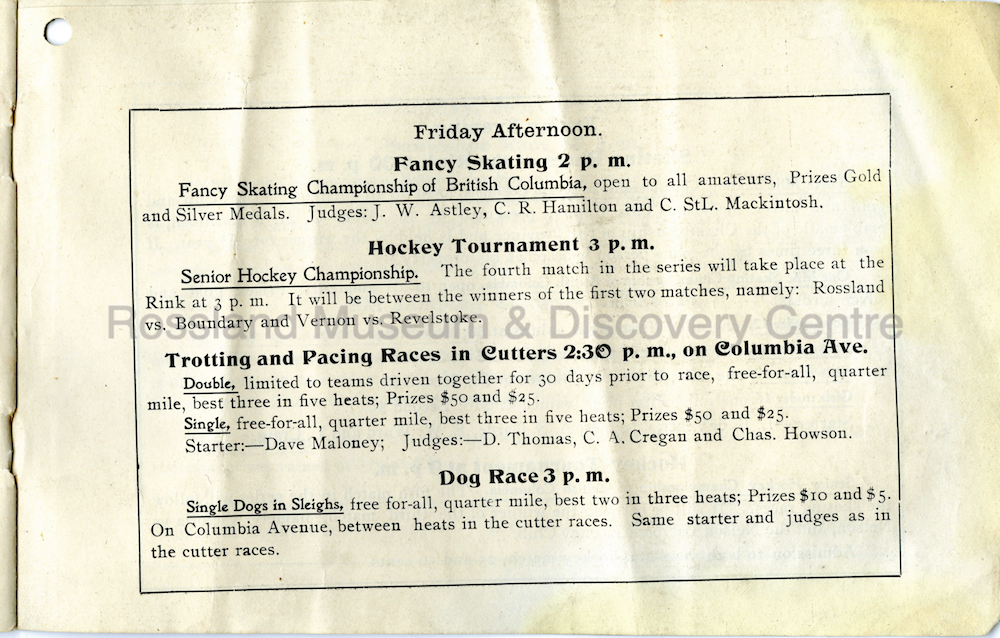
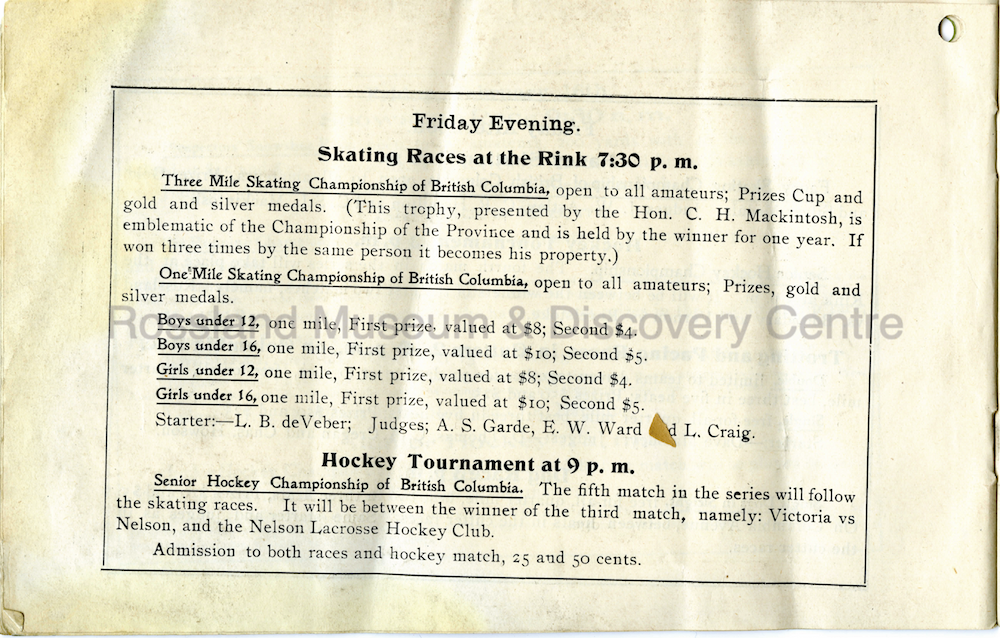
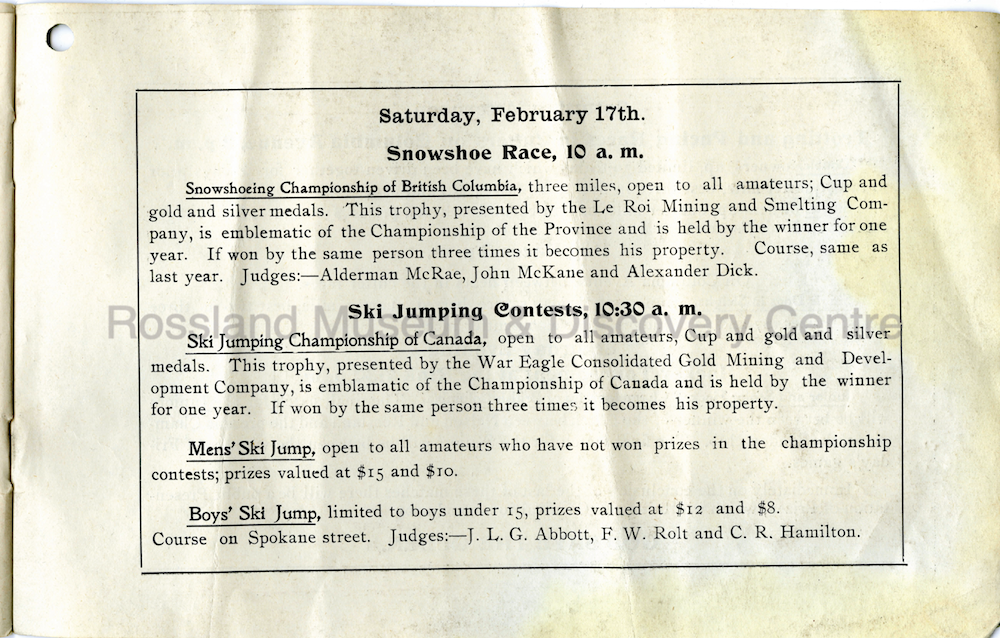
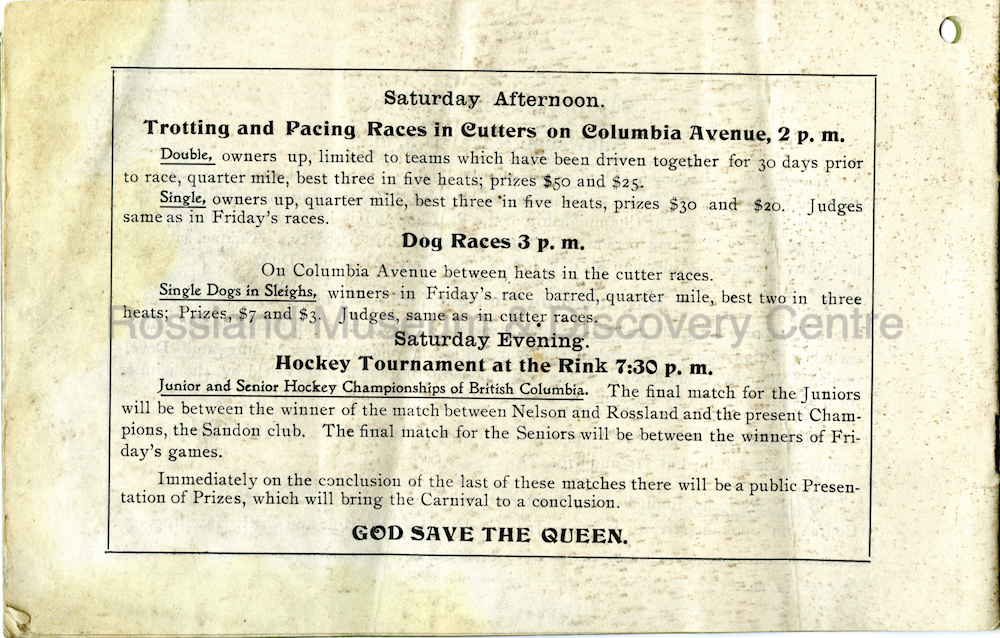
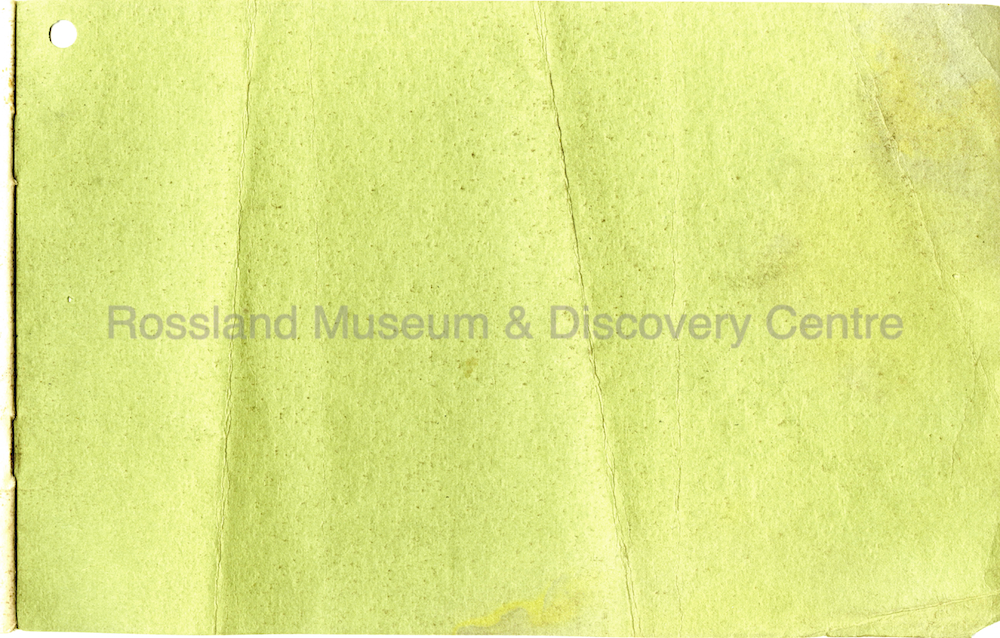

Snowshoeing
When we think of the first Winter Carnivals, we often remember the beginning of skiing and hockey in Rossland, but another popular event was snowshoeing. Many early Rosslanders snowshoed: it was both a practical skill and an easy leisure activity at a time when skiing was still a novelty in the region. From the first Winter Carnival in 1898 until 1912, snowshoe races found an important place, alongside ski racing, hockey, skate racing, and other festivities. The races would later be joined by more theatrical events like “Storming the Fort” and torchlight parades through town. Although these events are no longer part of the Winter Carnival, their effect is still felt through the love of snowshoeing many locals hold today.
Snowshoe Races
Snowshoe races were part of the 1898 Winter Carnival - two 3-mile races through Rossland. To keep things interesting, the types and distances of races changed from year to year. Distances ranged from 100-yard sprints to 3-mile races. Races also included many categories, including the “Championship of British Columbia,” a “prospectors race,” women’s races, boys, girls, and novice categories, and a “fat man’s race.” Since only a few races were held each year, the races were rarely the same two years in a row and often reflected the level of interest in snowshoeing at the time. The rules were also inconsistent between years, so a “prospectors race” sometimes simply described who was allowed to participate, and in other years required racing while carrying 40 or 50 lbs on one’s back. By the 1910s, interest in snowshoe racing was declining; the last race was held in 1912.
The Championship Snowshoe Race of British Columbia
The main snowshoe race of the Winter Carnival was the Championship Race of British Columbia. Despite its ambitious name, this was an amateur competition and it is unlikely that Winter Carnival organizers consulted the rest of B.C. before establishing this title. The winner was awarded a silver cup, originally donated by the Le Roi Mine. This he would keep until the next Winter Carnival, unless he won three years in a row. If he pulled off this feat, he got to keep the cup permanently - and donate a new trophy for the following year’s competition. The 3-mile course down Columbia Avenue and through lower Rossland was originally set in 1898 by “Father Pat” (Rev. Henry Irwin); it continued to be used until 1909.
The first Championship was a memorable one. The snowshoes of one contestant, A.C. Campbell, fell off four times before he finally forfeited. His problems were reportedly due to changing how he tied his laces, as he was typically quite a fast snowshoer. The winner, Fred Wells, got so far ahead he paused to let the other racers catch up. Wells would go on to win the 1899 and 1900 races as well, meaning he got to keep the original trophy and in 1901 donated the Wells Cup for future snowshoe races.
The Rossland Snowshoe Club
While the snowshoe races had been around since the beginning of the Carnival, the Rossland Snowshoe Club was responsible for adding “Storming the Fort.” This club began in the late 1890s and was heavily influenced by French Canadian Rosslanders such as J. Stephen Deschamps, who served as club president, C. O. LaLonde, and Eugene Croteau. It was modeled after similar clubs found in Quebec, where elaborate uniforms were common. A uniform in white, red, and blue was proposed for the Rossland Snowshoe Club, which has been described as follows:
On his head was a blue tuque with white stripe and a long tassel. The coat is white blanket trimmed in red and blue and having a double row of large white buttons in front. There are epaulets on the shoulders of red and blue, and also a fancy capote. Underneath the coat is worn a white sweater. Around the waist was fastened a long blue sash. On the hands were heavy blue mitts. He wore white blanket knickerbockers with blue stockings. On his feet were a pair of fancy moccasins, and also a pair of snowshoes. (The Rossland Miner, Dec. 21, 1904)
It is unlikely that many members wore this uniform often, but overall the group was quite successful for its time, attracting around 100 participants for its Winter Carnival events and hosting several successful “tramps” or excursions throughout the winter.
Storming the Fort
In 1903, in an attempt to revitalize the Winter Carnival, a new theatrical event called “Storming the Fort” was added. This was a simulated military attack done on snowshoes, similar to the choreographed attacks on ice palaces at Montreal’s winter carnival. Rossland’s version of this spectacle was a small wooden fort on the side of Monte Cristo mountain made out of logs, brushwood, and tar barrels. One night of the Carnival, participants would snowshoe up the mountain carrying lighted torches, and then
... suddenly extinguish their torches upon arriving within attacking distance of the fort. Then, while in darkness, the snowshoers will form into a long semicircle and in this manner advance upon the fort, firing as they go. After the fort has been taken it will be given up to the flames and the attackers and their prisoners will return to town. (The Rossland Miner, Feb. 7, 1903)
They did this for three years, giving the fort a new name each year. The forts were named: Fort Deschamps (after the club president, 1903), Fort Monte Cristo (1904), and Port Arthur (after the site of the Russo-Japanese War, 1905). Participation was quite high, with as many as 100 participants. It is unknown why exactly this event stopped after only three years, but possible reasons include high costs and declining interest.
The Masked Skater: Rossland’s Winter Carnival Masquerades
Today, the Sonny Samuelson Bobsled Race is one of the most colourful, creative features of the Rossland Winter Carnival. But for the early Winter Carnivals, it was the masquerade on ice that held this honour. A skating masquerade was introduced to Rossland in 1897 as a standalone event - the “Grand Masquerade Carnival” - and the skating masquerade was an integral part of the first Rossland Winter Carnival in 1898. By 1899, the masquerade was the opening event for the Carnival.
The event was so popular with Rosslanders that masquerades on ice were held throughout the winter months. The masquerade was also one of the only Winter Carnival events that carried on after the Winter Carnival ended in 1917.
While no longer part of the Winter Carnival festivities, the merry masquerader’s spirit has been preserved and is embodied by all who partake in the Carnival. Who knows, maybe in the future masked skaters will grace the Rossland Winter Carnival once again.
To participate was simple – you just needed a costume (or fancy dress), skates, and of course a mask. The event was open to the public, with the “merry masqueraders” on the ice from 8:00-9:30 pm. One of the city’s various bands would be on hand to provide music for the festivities. Spectators were welcomed onto the ice after the prizes were awarded.
There were six main prize categories: women, men, girls, boys, and couples (both adult and young). As the masquerades continued, new categories such as under 16, best ladies’ skater, and comic character were added. Some examples of prizes given include an ivory fan, gold bracelet, pipes, boxing gloves, silver vase, wool muffler, and gold cuff links.
The costumes ranged in theme, detail, and creativity, but the masked skaters never failed to awe the audience. With upwards of 200 participants at the masquerades, some costumes were more common than others, but it was the more unique costumes that captured the judges’ attention. Some of the more notable costumes were John Bull, Rossland Resources, Night, a Kodak girl, and Kellogg’s Cornflakes.
Hockey
Hockey was always a key component of Rossland Winter Carnivals.
2285.0022: Sandon Junior Hockey Team Champions of BC, Winter Carnival 1898
The Sandon Junior Hockey Team Champions of BC and retainers of the Ross Thompson Trophy. Presented to the Rossland Winter Carnival in 1898. It was won by Sandon three times in succession and returned to the Rossland Historical Museum.
Rossland Miner, February 13, 1915.
The Rossland Ladies’ Hockey Team
The 1900 Winter Carnival saw the introduction of the Rossland Ladies’ Hockey Team. Originally formed as a “novelty,” the Rossland Ladies’ Hockey Team quickly gained fame outside of the Winter Carnival and became a pioneer in women’s sports.
The team was undefeated in organised competitions between 1900-1917, winning the Ladies’ Hockey Championship of BC every year. In 2014, the Rossland Ladies’ Hockey Team received the Pioneer Award from the BC Hockey Hall of Fame; the team was formally recognized for their accomplishments by the BC Sports Hall of Fame in 2018.
In contrast to modern hockey attire, the team's uniform consisted of an ankle-length black dress and a matching scarf. During the 1910s, the uniform transitioned to a knit sweater, black shirt, and toque.
1957.152.1: Hockey Pin
Rossland Winter Carnival Hockey Pin, 1915.
The End of the Early Carnivals
Rossland Winter Carnivals continued to be held annually for twenty years. During the war years 1915-18, it became more complicated to hold the event. There was considerable debate about whether it was socially responsible to hold a recreational event during wartime, when Canadians were continually being urged to “do their bit” by saving food and expenses. Addressing these concerns, the Miner reported in 1917 that “everyone contributing can feel safe in the enjoyment of the fact that the funds were carefully administered and the carnival conducted in a business-like manner.” Additionally, proceeds from the 1916 and 1917 Carnival were donated to the Patriotic, Red Cross and Belgian Relief funds.
“Rosslanders as a rule are not easily discouraged, and when they determine upon doing a thing, it is done. Good men and true, wishing to see the continuity of the always-looked forward to annual event maintained, especially this occasion marked the twentieth anniversary of like events in Rossland, banded together and determined to continue the annual custom since Rossland had enjoyed the winter festival since the time of its inception without a break.”
In 1918, no carnival was held. We have not found any definite explanation for this, but the continuing war effort was likely a factor. The town was also suffering from an economic downturn from 1918 and through the ‘20s as mines began to close; it may well have become difficult to justify the expenses required to launch another Carnival. Additionally, the Spanish Influenza pandemic hit Rossland and Trail in the fall of 1918, resulting in closed theatres and cancelled public gatherings, which likely also had a bearing on the decision to hold off on further Winter Carnival celebrations.
A more modest “Skating Carnival” event was held in January 1918. “It has been a long time since Rossland has enjoyed an old-time masquerade,” the Miner wrote, “the last one being held last winter when the carnival program was being carried out.” Echoing the masquerades of previous years’ Carnivals, the evening involved skating and costume contests, with live music provided by the Trail Italian band. Clearly, Rosslanders were still in the mood to celebrate winter sports! However, for whatever reason, the Winter Carnival tradition was put on pause following February 1917, and would not return in full until 1947.
The Sno Sho
Rossland Miner, Jan 9th 1947
The Carnival finally made its jubilant return in 1947. “Although lacking in many respects the glamour and stage-settings employed in the winter carnivals of the early 1900’s,” wrote the Miner, “Rossland’s three-day Snow Carnival … promises to be the first major attempt in reviving the winter festivities for which the city was so renowned in the early days.” The event was arranged in conjunction with the Kootenay Zone Ski Tournament, and - as in the early days - would “offer residents of the city and district an opportunity to participate in practically every known snow sport,” including skating, hockey, ski joring, ski jumping, and bobsledding. 1947 was also the introduction of the “Snow Queen Contest,” a pageant which continued to run through the 1950s. The Miner proclaimed that the “four-day Winter Carnival promises to be biggest event in years.” The newly reinstated Carnival came off so well that the only apparent suggestions were to additions to the size and scope of activities, including to “increase the thrill of the toboggan run.”
The Rossland Miner - January 1947
The following year’s Carnival was dubbed “The Rossland Winter Carnival Sno-Sho of 1948,” and proved to be yet another resounding success. The “Sno-Sho” title continued to be used through the 1950s.
Modern Day Winter Carnival
The Rossland Winter Carnival is going strong today - held annually over the final weekend in January. Annual events include Night Parade, Sonny Samuelson Bobsled Race, Blizzard Music Festival, Variety Show, King of the Mountain Tri-discipline (Ski, Telemark, Snowboard) Race, Rail Jam, Ice Palace, Rossland Mountain Market, Snow Volleyball Tournament, Olaus Invitational BC Cup Luge Race, John Heintz Relay Race (downhill ski, nordic ski, bike, snowshoe, and run), Snowman-making competition (here at the museum), and much more!
Rick Mercer heads to Rossland, BC to take in the longest running winter carnival in Canada. 2010
For More Information:
Ron Shearer Essay, Mid-Winter Mardi Gras: The Rossland Winter Carnival
Present-Day Rossland Winter Carnival Website
Contribute your own memories/experiences of the Rossland Winter Carnival:
The form below will email us your message. If you prefer to speak to us directly or have other questions or comments about this page, please call (250) 362-7722 or email the archives directly at archives@rosslandmuseum.ca





